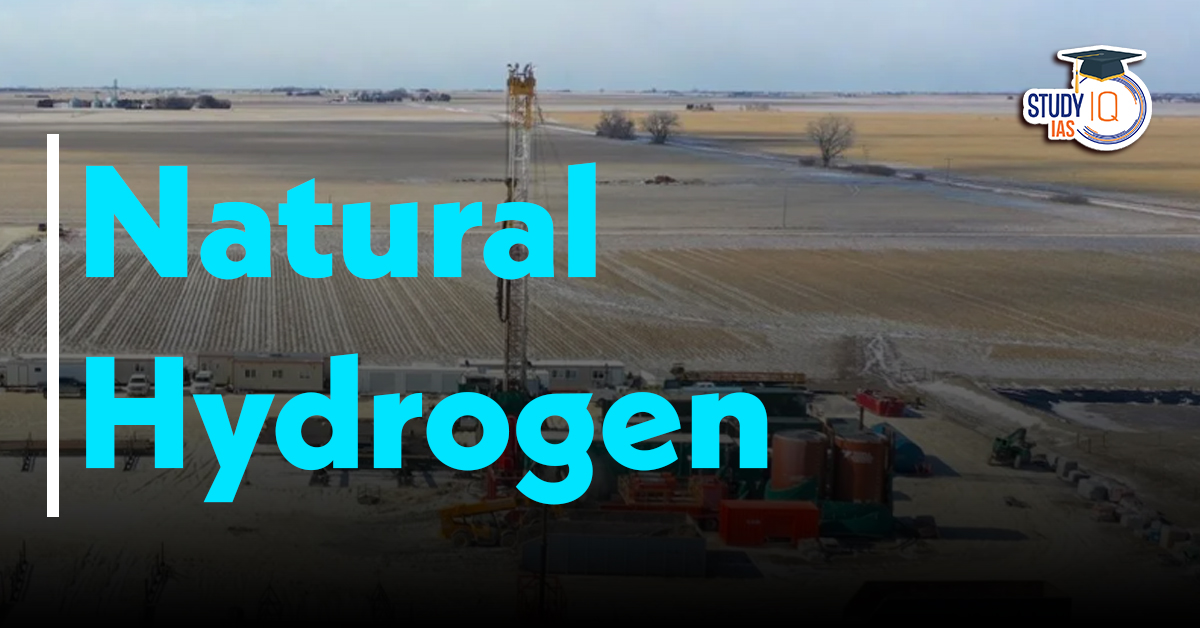Table of Contents
Context
- Hydrogen is emerging as a clean energy carrier, crucial for global decarbonisation and combating climate change.
- While green hydrogen is resource-intensive, the discovery of natural (geological) hydrogen presents a low-cost and sustainable alternative.
- If effectively tapped, natural hydrogen could transform energy security and support India’s net-zero ambitions.
Understanding Natural Hydrogen
Conventional vs. Natural Hydrogen
Conventional hydrogen is primarily produced using fossil fuels (e.g., steam methane reforming), while green hydrogen uses renewable energy—both are resource-heavy. Natural hydrogen, formed geologically, offers a low-carbon and potentially low-cost alternative.
Geological Formation
Natural hydrogen originates from:
- Serpentinisation of ultramafic rocks.
- Radiolysis of water by radioactive elements.
- Thermal breakdown of organic material at depth.
Discovery and Global Interest
- In Mali (1987), a failed water drilling attempt uncovered a 98% pure hydrogen source.
- Since then, research has identified seeps in France, Spain, the U.S., Australia, and India, sparking global exploration.
Global Reserve Estimates and Market Momentum
- USGS Estimate (2022): Tens of trillions of tonnes of natural hydrogen may exist globally. Even if only 2% is usable, it could meet global demand for 200 years.
- Recent Discoveries:
- France’s Lorraine and Moselle regions hold ~92 million tonnes (worth $92 billion).
Industry Growth
- Companies in over 10 countries are now exploring natural hydrogen.
- The cost of production is estimated at $1/kg, cheaper than green and grey hydrogen.
- Major investments include $245 million for U.S.-based Koloma from Amazon and Gates-backed ventures.
India’s Strategic Opportunity
Geological Potential
- India’s ophiolite complexes, greenstone belts, cratonic basins, and geothermal regions are rich in natural hydrogen potential.
- A preliminary estimate suggests 3,475 million tonnes of reserves.
Alignment with Energy Goals
- India’s hydrogen demand is expected to grow from 6 Mt/year (2020) to over 50 Mt/year by 2070.
- Natural hydrogen can support India’s net-zero 2070 target, reduce reliance on fossil fuels, and enhance energy sovereignty.
Challenges in Exploration and Utilisation
- Lack of Standard Techniques: Unlike oil and gas, there are no proven methods for locating or quantifying natural hydrogen accurately.
- Technical Barriers: High diffusivity and reactivity of hydrogen complicate extraction and containment.
- Infrastructure and materials may degrade without protective coatings or design adjustments.
- Regulatory and Safety Concerns: Absence of policy frameworks for natural hydrogen exploration.
- High flammability and reactivity demand strict safety protocols.
Policy and Technological Way Forward
- National Survey and Mapping: India can replicate the SRRA model (used for solar mapping) via a public-private hydrogen resource atlas.
- R&D and Demonstration Projects: Inspired by the U.S. ARPA-E model, India can explore:
- Water-rock reactions.
- CO₂ injection in iron-rich formations to produce hydrogen and store carbon simultaneously.
- Leveraging Existing Infrastructure: Oil & gas sector assets (wells, cores, pipelines) can be adapted for hydrogen exploration and transport.
- Institutional and Regulatory Support: Provide exploration incentives.
- Establish hydrogen-specific extraction norms.
- Develop a regulatory body or empower the Directorate General of Hydrocarbons for oversight.
Conclusion
Natural hydrogen represents a game-changing opportunity for India’s energy transition. With the right investments in geoscientific mapping, policy reforms, and technological innovation, India can emerge as a leader in natural hydrogen exploration. Unlocking this potential will not only help meet climate targets but also boost economic and strategic resilience.


 List of National Parks in India 2025, Ch...
List of National Parks in India 2025, Ch...
 Bonnet Macaques: Habitat, Features, Beha...
Bonnet Macaques: Habitat, Features, Beha...
 Periyar Tiger Reserve, Map, Flora, Fauna...
Periyar Tiger Reserve, Map, Flora, Fauna...

























